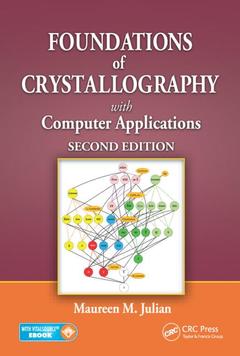Description
Foundations of Crystallography with Computer Applications (2nd Ed.)
Author: Julian Maureen M.
Language: English
Subjects for Foundations of Crystallography with Computer Applications:
Keywords
Unit Cell; Fractional Coordinates; Reciprocal Lattices; Asymmetric Unit; Maximal Subgroups; Crystallographic Information File; Space Group; Point Group; Basis Vectors; Space Group P1; 3K Br12; Inversion Point; Crystal System; Symbol Diagram; Twofold Rotation; Mirror Planes; Reciprocal Unit Cell; Rotation Axis; Miller Indices; Lattice Parameters; Vice Versa; Atomic Scattering Factor; Electron Density Map; Twofold Rotation Axis; Stereographic Projections
680 p. · 17.8x25.4 cm · Paperback
Description
/li>Contents
/li>Biography
/li>
Taking a straightforward, logical approach that emphasizes symmetry and crystal relationships, Foundations of Crystallography with Computer Applications, Second Edition provides a thorough explanation of the topic for students studying the solid state in chemistry, physics, materials science, geological sciences, and engineering. It is also written for scientists who want to teach themselves. Computers are an essential part of crystallography, and computer-based exercises are integrated into this book. The material is presented with the goal of creating an understanding of how atoms are arranged in crystals and how crystal systems are related to each other.
See What?s New in the Second Edition:
- Eight new chapters that give detailed crystallographic analyses of one crystal chosen for each crystal system
- Numerous molecular examples and suggestions for student projects
- Coverage of special topics that naturally arise in the treatment of the crystals
- Suggestions for student projects with date that can be found in the free Teaching Subset of the Cambridge Structural Database
- Point group and space group diagrams have been color coded using a new scheme devised by the author to emphasize the change of handedness of the symmetry operations
- All the Starter Programs have been rewritten and improved, and a new one has been added in Chapter 6 on the graphing of intensity vs. 2? for powder diffraction data
- New appendices contain detailed information about the 32 three-dimensional point groups and the 10 two-dimensional point groups
The book explains the individual entities, such as symmetry operations, and also explains how they fit together in a larger context. Coverage includes lattices, symmetry operations, metric matrices, point groups, space groups, reciprocal lattices, properties of x-rays, and electron density maps, all leading to a formal description of the crystal structures and an interpretation of the published crystallographic data. The author connects general properties such as the piezoelectric effect, compressibility, thermal expansion, and Mosely?s relationship in ordering the elements of the periodic table giving students a thorough foundation in the subject.
Print Versions of this book also include access to the ebook version.




